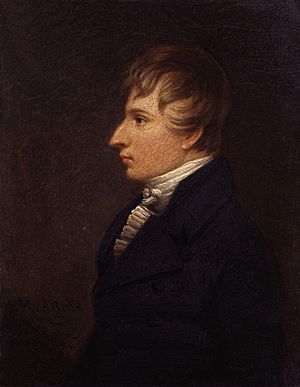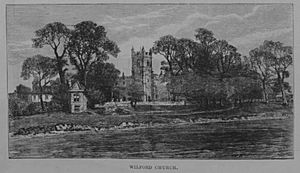Henry Kirke White facts for kids
Henry Kirke White (born March 21, 1785 – died October 19, 1806) was an English poet and writer of hymns. He passed away at the young age of 21.
Life Story
White was born in Nottingham. His father was a butcher, and Henry was expected to follow in his footsteps. However, he loved learning from books more than anything. By age seven, he was secretly teaching a family servant to read after everyone else was asleep!
After a short time working for a stocking-weaver, he became a lawyer's assistant for George Coldham. While working there, he became very good at studying Latin and Greek. His health began to get worse because of a serious illness called tuberculosis. His employers gave him a month off. He chose to live in Wilford between 1804 and 1805. Much of his poetry was inspired by Wilford and the areas around it.
He wrote many of his poems in a small building called a gazebo. This gazebo still stands in the grounds of St Wilfrid's Church, Wilford. Here is what he wrote about this spot:
Here would I wish to sleep, this is the spot
Which I have long marked out to lay my bones in.
Tired out and wearied with the riotous world,
Beneath this yew would I be sepulchred.
Seeing how hard White studied and how his health was failing, his boss offered to let him leave his job if he could afford to go to college. He received help from Capel Lofft, a friend of Robert Bloomfield. In 1803, at age 17, he published a book of poems called Clifton Grove, a Sketch in Verse, with other Poems. This book was dedicated to Georgiana, Duchess of Devonshire. Some well-known poems from it were 'The Fair Maid of Clifton' and 'Clifton Grove'.
His book was strongly criticized by a magazine called the Monthly Review in February 1804. But White also received a kind letter from the famous writer Robert Southey.
With the help of his friends, Henry was able to go to St John's College, Cambridge. Before that, he spent a year studying with a private teacher, Reverend Lorenzo Grainger, in Winteringham. Studying so much made his health even worse. He suffered from tuberculosis, a disease he often mentioned in his poems and letters.
People worried about his mental health, but he started at Cambridge in the autumn of 1805, planning to become a priest. The stress of constant study quickly worsened his already poor health, leading to his death.
He was buried in the church of All Saints' Jewry in Cambridge. This church was across from the gates of St John's College, but it has since been taken down. The stone monument marking his grave was made by Francis Chantrey.
His religious poems were very sincere. This helped some of his hymns become popular, especially 'O Lord, another day is flown', which is still sung today. Much of his fame came from the sadness people felt about his early death. But Lord Byron agreed with Southey that the young man had great promise. Robert Southey said that Henry "could not rest satisfied till he had formed his principles upon the basis of Christianity."
You can see a metal plaque in Exchange Arcade, Cheapside in Nottingham. It marks the spot where Kirke White was born. The original plaque was on his actual home, but it was moved when the house was torn down to build the Council House.
St Wilfrid's Church, Wilford has two memorials for him. One is a marble plaque inside the church. The second is a beautiful stained glass window from around 1870, made by O'Connor.
Literary Works
His collected writings, called Remains, included his letters and a story of his life. These were put together by Robert Southey and published in several volumes between 1807 and 1822. White's letters and poems contain many details about himself, almost like an autobiography.
Lord Byron wrote a tribute to White, saying that "while life was in its spring, thy young muse just waved her joyous wing." White's complete works were published in 1923.
Hymns
- 'Oft in danger, oft in woe'




